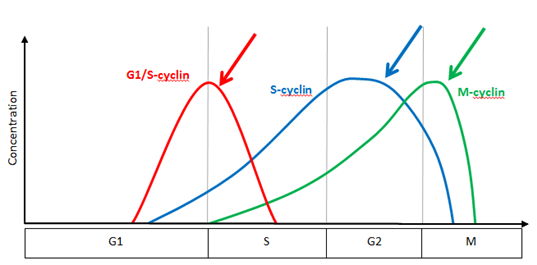The threads that make up the mycelium of a fungal body are called:
a. yeast.
b. thallium.
c. spores.
d. hyphae.
e. fruiting bodies.
Ans: d. hyphae.
You might also like to view...
The following graph represents the concentration of cyclins over the course of the cell cycle. Which of the following statements is TRUE regarding the phase of the cell cycle where the red arrow is pointing?

A. At this point in the cell cycle, all sister chromatids are fully formed.
B. At this point in the cell cycle, DNA has already been replicated correctly.
C. At this point in the cell cycle, chromosomes have properly aligned on the metaphase plate and are beginning to separate.
D. At this point in the cell cycle, the cell is determining if conditions are favorable for cell division.
E. At this point in the cycle the cell is continuing to grow and make abundant tubulin proteins.
Which molecules are broken down by trypsin, elastase, and chymotrypsin?
a. lipids b. proteins c. peptides d. amino acids
Gelatinous matrix What is the gelatinous matrix inside chloroplasts that contains ribosomes, DNA, and enzymes?
a) granum b) chlorophyll c) thylakoid d) stroma e) mitochondria
A population of butterflies has an allele B for big spots on the wings and b for small spots on the wings. The table below provides data about this population
Genotype BB Bb bb Number of butterflies 300 400 300 Genotype frequency 0.3 0.4 0.3 Regarding these data about the butterfly population, which of the following statements is correct? A) The population is in Hardy-Weinberg equilibrium because the number of B alleles is equal to the number of b alleles. B) The population is in Hardy-Weinberg equilibrium because half of the heterozygotes are B and half are b. C) The population is not in Hardy-Weinberg equilibrium because p2 and 2pq are different. D) The population is not in Hardy-Weinberg equilibrium because the genotype frequency of bb is greater than it would be in equilibrium.